Investigating Talent Strategies for Successful Business Projects
VerifiedAdded on 2023/06/18
|24
|4340
|235
Project
AI Summary
This project investigates talent management strategies used by successful companies, focusing on attracting and retaining top talent to enhance business project outcomes. The research aims to analyze the impact of these strategies on productivity and business performance, using Sainsbury's as a case study. The project covers project planning, secondary research exploring talent management concepts, and strategies such as training, development, rewards, and recognition. The research methodology employs a positivism philosophy and a deductive approach, utilizing quantitative research methods with both primary and secondary data collection. Ethical considerations are addressed, and data analysis involves frequency distribution analysis to ensure the reliability and validity of the findings. Desklib provides access to similar past papers and solved assignments for students.
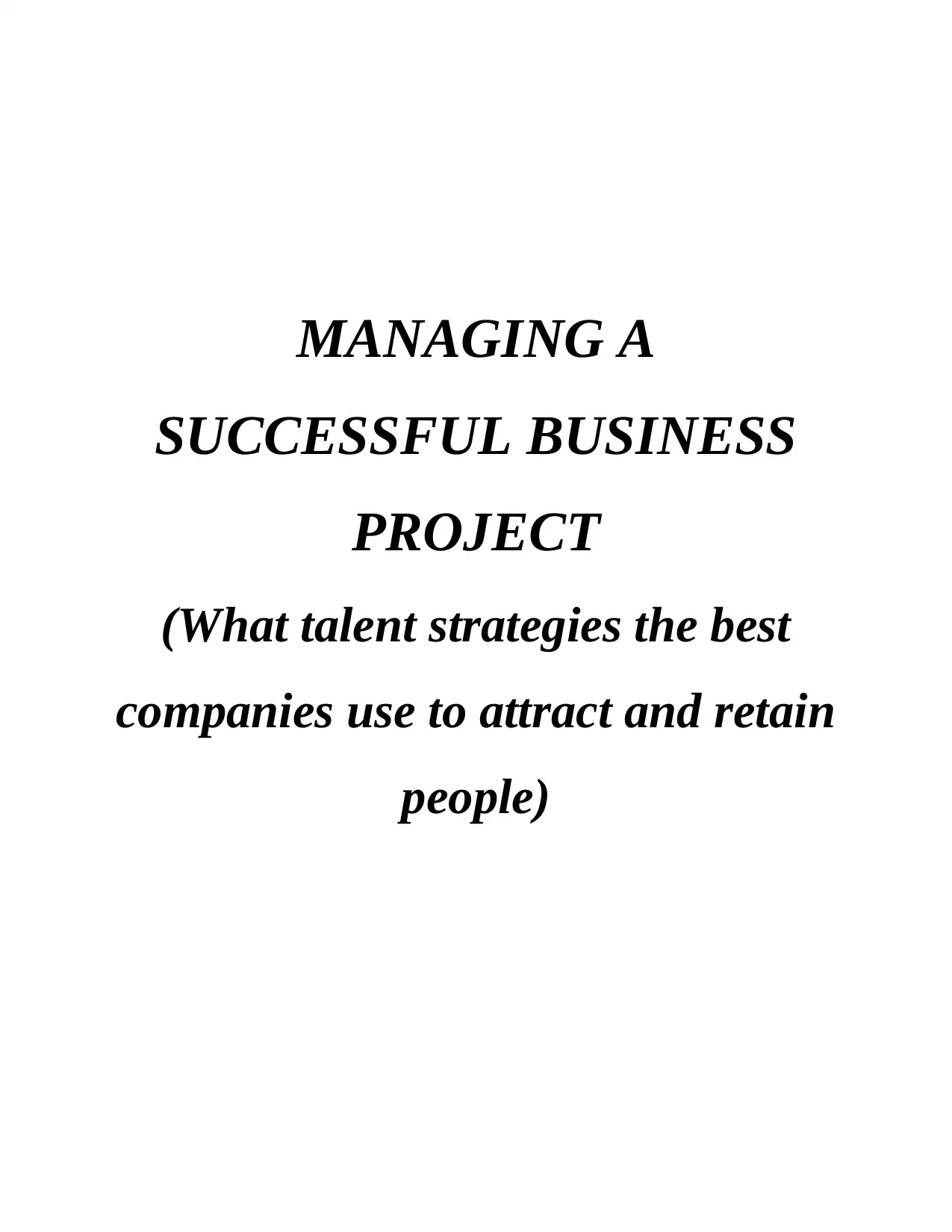
MANAGING A
SUCCESSFUL BUSINESS
PROJECT
(What talent strategies the best
companies use to attract and retain
people)
SUCCESSFUL BUSINESS
PROJECT
(What talent strategies the best
companies use to attract and retain
people)
Paraphrase This Document
Need a fresh take? Get an instant paraphrase of this document with our AI Paraphraser
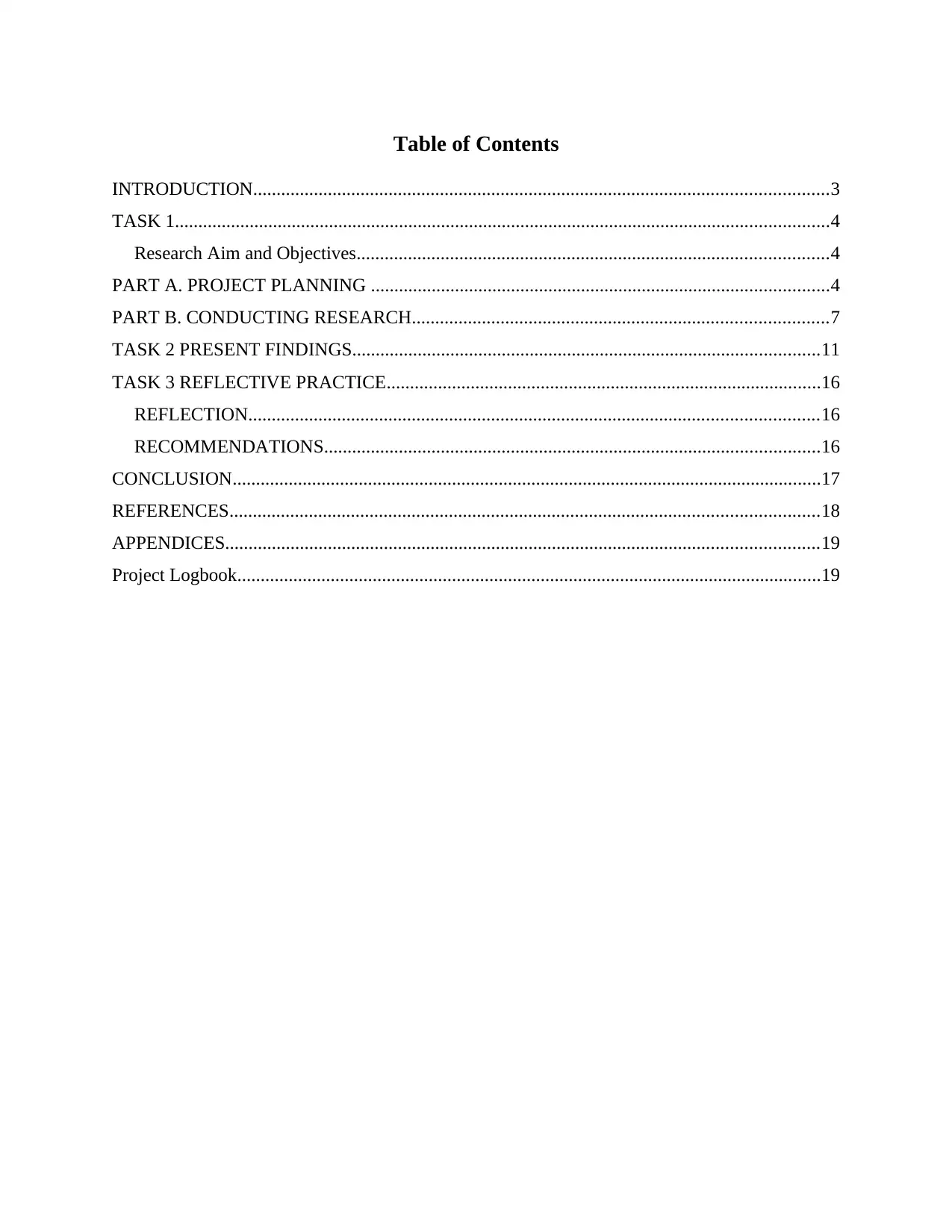
Table of Contents
INTRODUCTION...........................................................................................................................3
TASK 1............................................................................................................................................4
Research Aim and Objectives.....................................................................................................4
PART A. PROJECT PLANNING ..................................................................................................4
PART B. CONDUCTING RESEARCH.........................................................................................7
TASK 2 PRESENT FINDINGS....................................................................................................11
TASK 3 REFLECTIVE PRACTICE.............................................................................................16
REFLECTION..........................................................................................................................16
RECOMMENDATIONS..........................................................................................................16
CONCLUSION..............................................................................................................................17
REFERENCES..............................................................................................................................18
APPENDICES...............................................................................................................................19
Project Logbook.............................................................................................................................19
INTRODUCTION...........................................................................................................................3
TASK 1............................................................................................................................................4
Research Aim and Objectives.....................................................................................................4
PART A. PROJECT PLANNING ..................................................................................................4
PART B. CONDUCTING RESEARCH.........................................................................................7
TASK 2 PRESENT FINDINGS....................................................................................................11
TASK 3 REFLECTIVE PRACTICE.............................................................................................16
REFLECTION..........................................................................................................................16
RECOMMENDATIONS..........................................................................................................16
CONCLUSION..............................................................................................................................17
REFERENCES..............................................................................................................................18
APPENDICES...............................................................................................................................19
Project Logbook.............................................................................................................................19
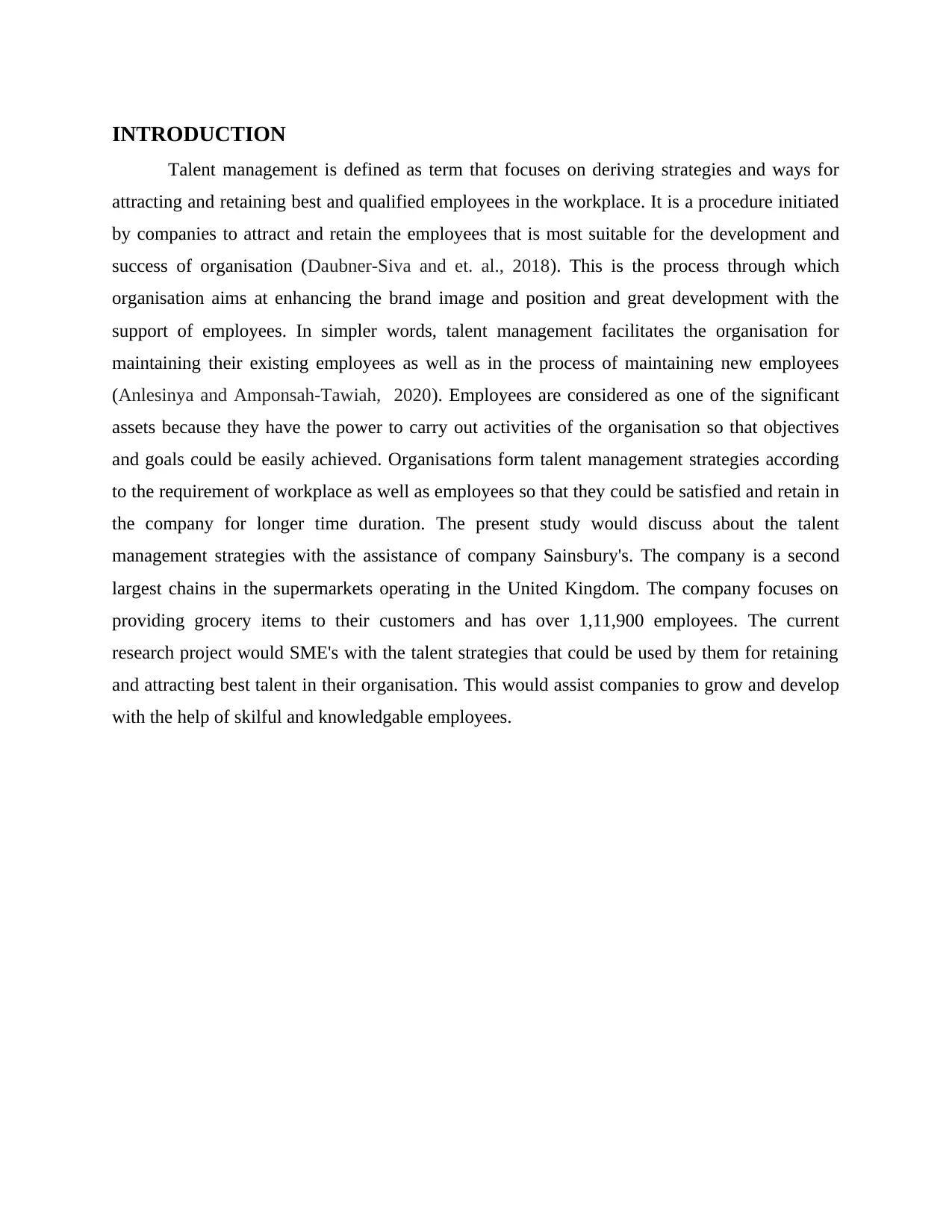
INTRODUCTION
Talent management is defined as term that focuses on deriving strategies and ways for
attracting and retaining best and qualified employees in the workplace. It is a procedure initiated
by companies to attract and retain the employees that is most suitable for the development and
success of organisation (Daubner-Siva and et. al., 2018). This is the process through which
organisation aims at enhancing the brand image and position and great development with the
support of employees. In simpler words, talent management facilitates the organisation for
maintaining their existing employees as well as in the process of maintaining new employees
(Anlesinya and Amponsah-Tawiah, 2020). Employees are considered as one of the significant
assets because they have the power to carry out activities of the organisation so that objectives
and goals could be easily achieved. Organisations form talent management strategies according
to the requirement of workplace as well as employees so that they could be satisfied and retain in
the company for longer time duration. The present study would discuss about the talent
management strategies with the assistance of company Sainsbury's. The company is a second
largest chains in the supermarkets operating in the United Kingdom. The company focuses on
providing grocery items to their customers and has over 1,11,900 employees. The current
research project would SME's with the talent strategies that could be used by them for retaining
and attracting best talent in their organisation. This would assist companies to grow and develop
with the help of skilful and knowledgable employees.
Talent management is defined as term that focuses on deriving strategies and ways for
attracting and retaining best and qualified employees in the workplace. It is a procedure initiated
by companies to attract and retain the employees that is most suitable for the development and
success of organisation (Daubner-Siva and et. al., 2018). This is the process through which
organisation aims at enhancing the brand image and position and great development with the
support of employees. In simpler words, talent management facilitates the organisation for
maintaining their existing employees as well as in the process of maintaining new employees
(Anlesinya and Amponsah-Tawiah, 2020). Employees are considered as one of the significant
assets because they have the power to carry out activities of the organisation so that objectives
and goals could be easily achieved. Organisations form talent management strategies according
to the requirement of workplace as well as employees so that they could be satisfied and retain in
the company for longer time duration. The present study would discuss about the talent
management strategies with the assistance of company Sainsbury's. The company is a second
largest chains in the supermarkets operating in the United Kingdom. The company focuses on
providing grocery items to their customers and has over 1,11,900 employees. The current
research project would SME's with the talent strategies that could be used by them for retaining
and attracting best talent in their organisation. This would assist companies to grow and develop
with the help of skilful and knowledgable employees.
⊘ This is a preview!⊘
Do you want full access?
Subscribe today to unlock all pages.

Trusted by 1+ million students worldwide
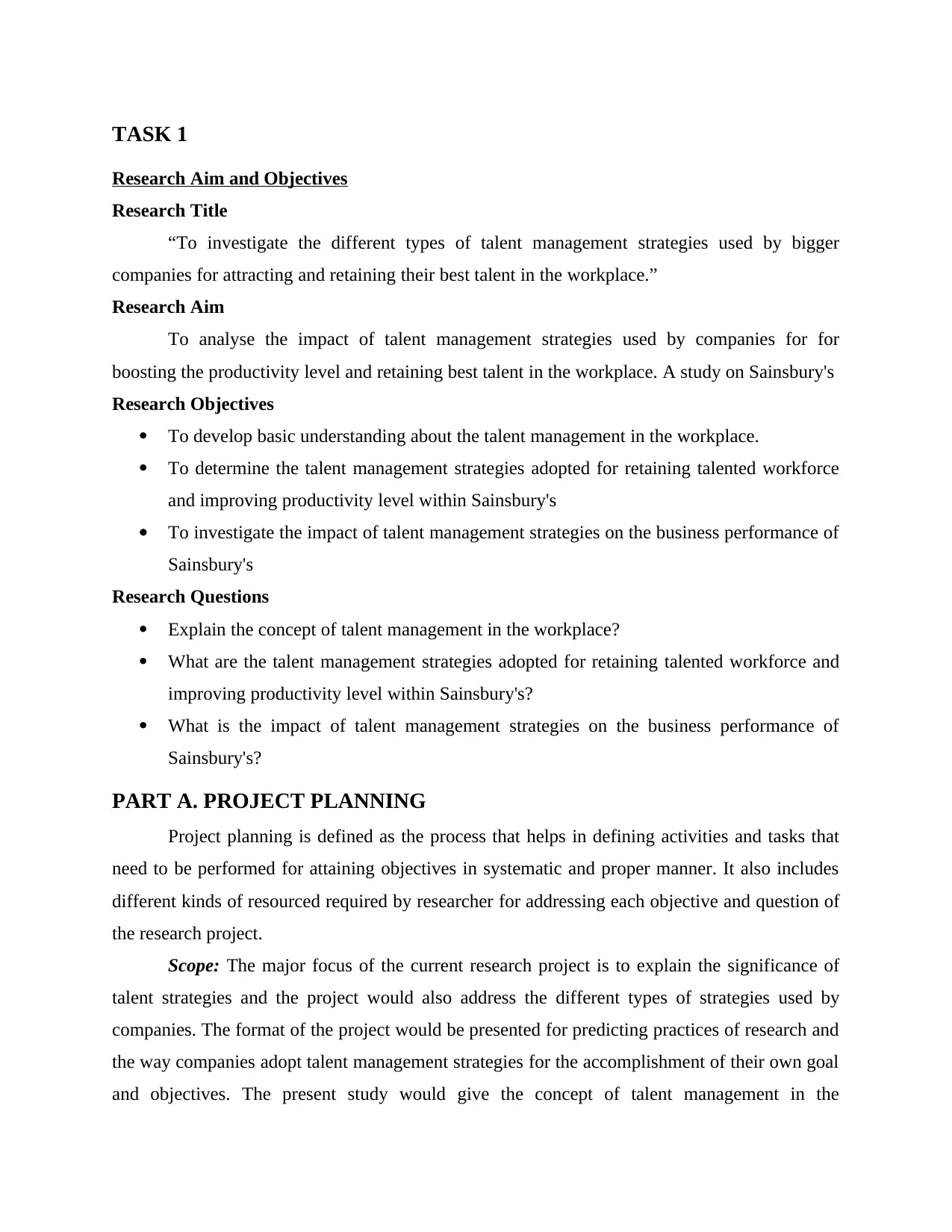
TASK 1
Research Aim and Objectives
Research Title
“To investigate the different types of talent management strategies used by bigger
companies for attracting and retaining their best talent in the workplace.”
Research Aim
To analyse the impact of talent management strategies used by companies for for
boosting the productivity level and retaining best talent in the workplace. A study on Sainsbury's
Research Objectives
To develop basic understanding about the talent management in the workplace.
To determine the talent management strategies adopted for retaining talented workforce
and improving productivity level within Sainsbury's
To investigate the impact of talent management strategies on the business performance of
Sainsbury's
Research Questions
Explain the concept of talent management in the workplace?
What are the talent management strategies adopted for retaining talented workforce and
improving productivity level within Sainsbury's?
What is the impact of talent management strategies on the business performance of
Sainsbury's?
PART A. PROJECT PLANNING
Project planning is defined as the process that helps in defining activities and tasks that
need to be performed for attaining objectives in systematic and proper manner. It also includes
different kinds of resourced required by researcher for addressing each objective and question of
the research project.
Scope: The major focus of the current research project is to explain the significance of
talent strategies and the project would also address the different types of strategies used by
companies. The format of the project would be presented for predicting practices of research and
the way companies adopt talent management strategies for the accomplishment of their own goal
and objectives. The present study would give the concept of talent management in the
Research Aim and Objectives
Research Title
“To investigate the different types of talent management strategies used by bigger
companies for attracting and retaining their best talent in the workplace.”
Research Aim
To analyse the impact of talent management strategies used by companies for for
boosting the productivity level and retaining best talent in the workplace. A study on Sainsbury's
Research Objectives
To develop basic understanding about the talent management in the workplace.
To determine the talent management strategies adopted for retaining talented workforce
and improving productivity level within Sainsbury's
To investigate the impact of talent management strategies on the business performance of
Sainsbury's
Research Questions
Explain the concept of talent management in the workplace?
What are the talent management strategies adopted for retaining talented workforce and
improving productivity level within Sainsbury's?
What is the impact of talent management strategies on the business performance of
Sainsbury's?
PART A. PROJECT PLANNING
Project planning is defined as the process that helps in defining activities and tasks that
need to be performed for attaining objectives in systematic and proper manner. It also includes
different kinds of resourced required by researcher for addressing each objective and question of
the research project.
Scope: The major focus of the current research project is to explain the significance of
talent strategies and the project would also address the different types of strategies used by
companies. The format of the project would be presented for predicting practices of research and
the way companies adopt talent management strategies for the accomplishment of their own goal
and objectives. The present study would give the concept of talent management in the
Paraphrase This Document
Need a fresh take? Get an instant paraphrase of this document with our AI Paraphraser
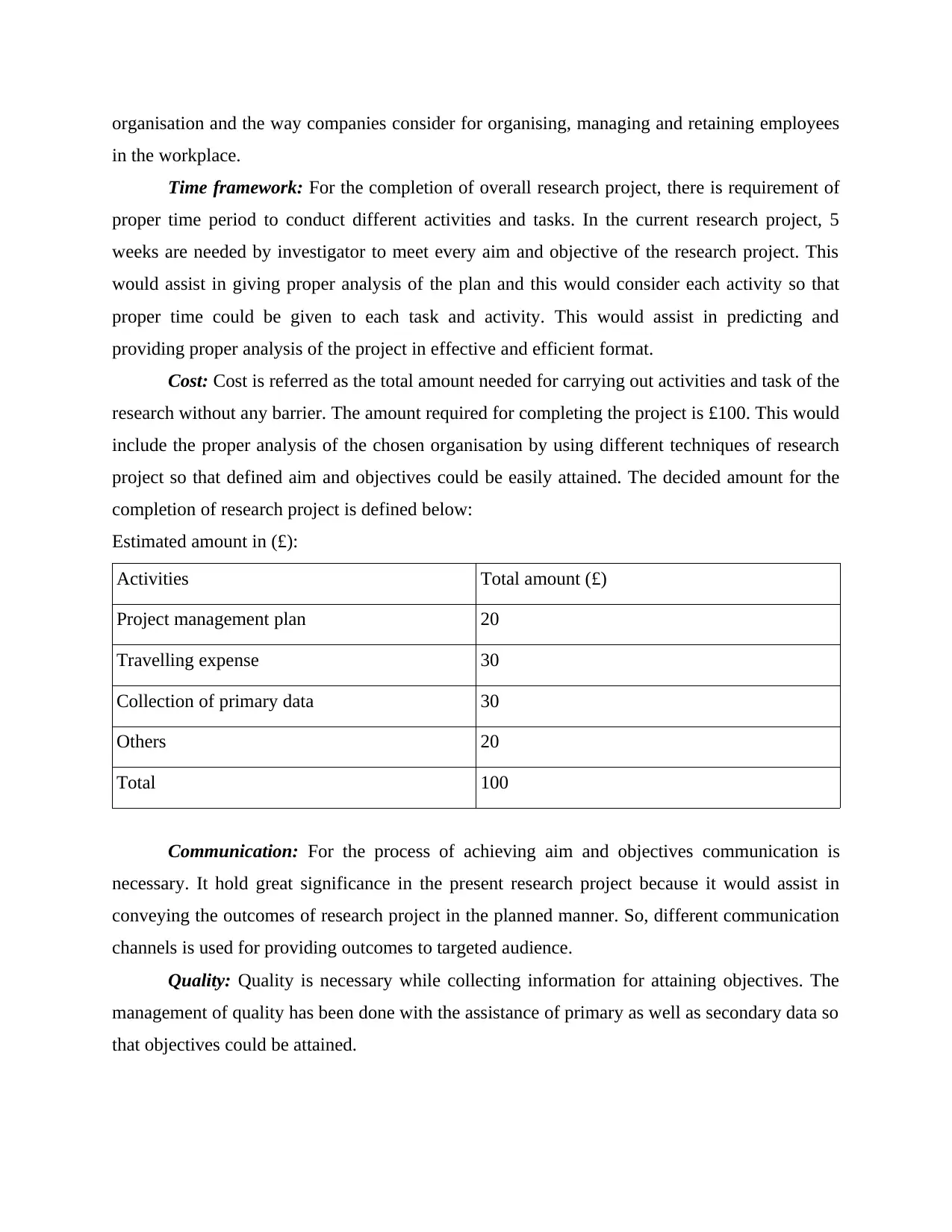
organisation and the way companies consider for organising, managing and retaining employees
in the workplace.
Time framework: For the completion of overall research project, there is requirement of
proper time period to conduct different activities and tasks. In the current research project, 5
weeks are needed by investigator to meet every aim and objective of the research project. This
would assist in giving proper analysis of the plan and this would consider each activity so that
proper time could be given to each task and activity. This would assist in predicting and
providing proper analysis of the project in effective and efficient format.
Cost: Cost is referred as the total amount needed for carrying out activities and task of the
research without any barrier. The amount required for completing the project is £100. This would
include the proper analysis of the chosen organisation by using different techniques of research
project so that defined aim and objectives could be easily attained. The decided amount for the
completion of research project is defined below:
Estimated amount in (£):
Activities Total amount (£)
Project management plan 20
Travelling expense 30
Collection of primary data 30
Others 20
Total 100
Communication: For the process of achieving aim and objectives communication is
necessary. It hold great significance in the present research project because it would assist in
conveying the outcomes of research project in the planned manner. So, different communication
channels is used for providing outcomes to targeted audience.
Quality: Quality is necessary while collecting information for attaining objectives. The
management of quality has been done with the assistance of primary as well as secondary data so
that objectives could be attained.
in the workplace.
Time framework: For the completion of overall research project, there is requirement of
proper time period to conduct different activities and tasks. In the current research project, 5
weeks are needed by investigator to meet every aim and objective of the research project. This
would assist in giving proper analysis of the plan and this would consider each activity so that
proper time could be given to each task and activity. This would assist in predicting and
providing proper analysis of the project in effective and efficient format.
Cost: Cost is referred as the total amount needed for carrying out activities and task of the
research without any barrier. The amount required for completing the project is £100. This would
include the proper analysis of the chosen organisation by using different techniques of research
project so that defined aim and objectives could be easily attained. The decided amount for the
completion of research project is defined below:
Estimated amount in (£):
Activities Total amount (£)
Project management plan 20
Travelling expense 30
Collection of primary data 30
Others 20
Total 100
Communication: For the process of achieving aim and objectives communication is
necessary. It hold great significance in the present research project because it would assist in
conveying the outcomes of research project in the planned manner. So, different communication
channels is used for providing outcomes to targeted audience.
Quality: Quality is necessary while collecting information for attaining objectives. The
management of quality has been done with the assistance of primary as well as secondary data so
that objectives could be attained.
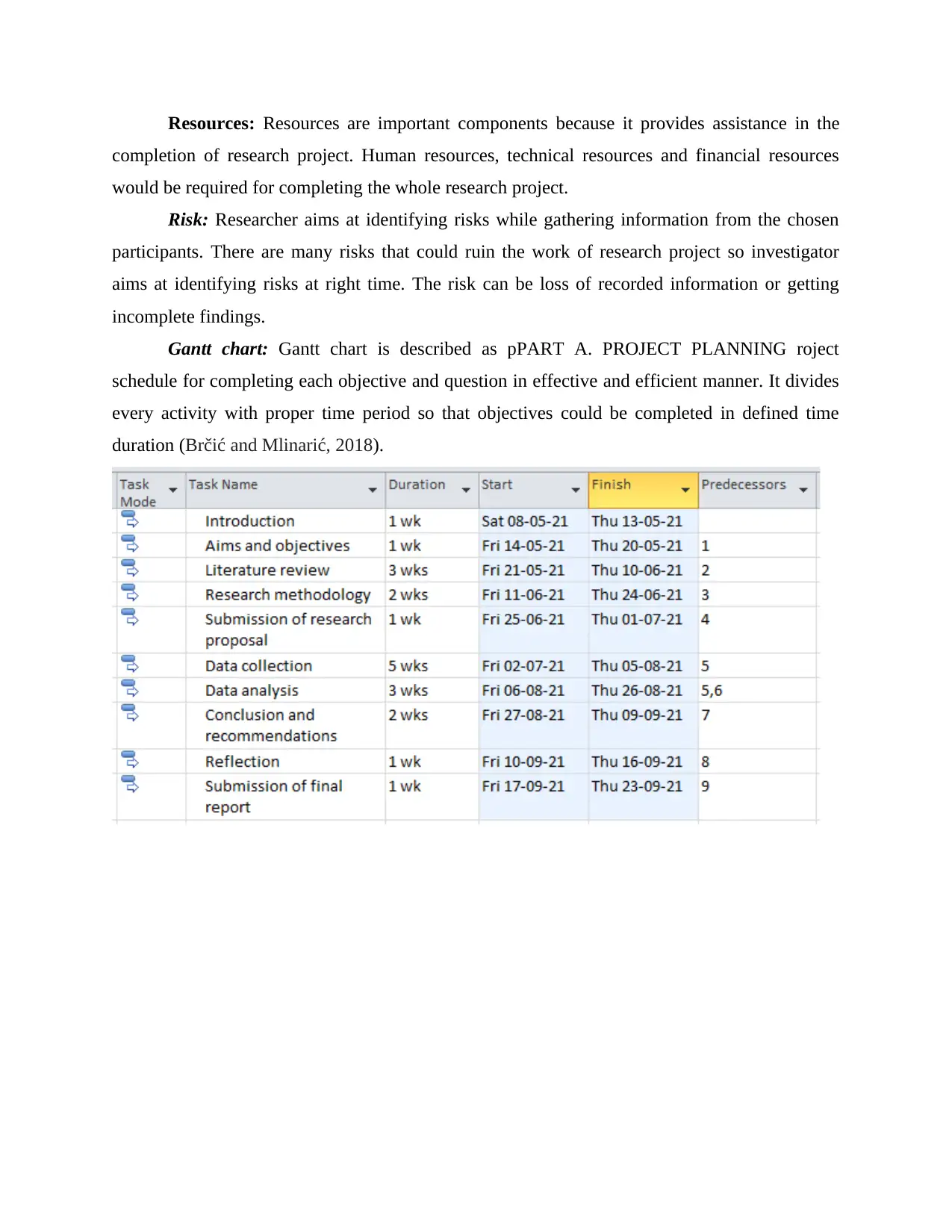
Resources: Resources are important components because it provides assistance in the
completion of research project. Human resources, technical resources and financial resources
would be required for completing the whole research project.
Risk: Researcher aims at identifying risks while gathering information from the chosen
participants. There are many risks that could ruin the work of research project so investigator
aims at identifying risks at right time. The risk can be loss of recorded information or getting
incomplete findings.
Gantt chart: Gantt chart is described as pPART A. PROJECT PLANNING roject
schedule for completing each objective and question in effective and efficient manner. It divides
every activity with proper time period so that objectives could be completed in defined time
duration (Brčić and Mlinarić, 2018).
completion of research project. Human resources, technical resources and financial resources
would be required for completing the whole research project.
Risk: Researcher aims at identifying risks while gathering information from the chosen
participants. There are many risks that could ruin the work of research project so investigator
aims at identifying risks at right time. The risk can be loss of recorded information or getting
incomplete findings.
Gantt chart: Gantt chart is described as pPART A. PROJECT PLANNING roject
schedule for completing each objective and question in effective and efficient manner. It divides
every activity with proper time period so that objectives could be completed in defined time
duration (Brčić and Mlinarić, 2018).
⊘ This is a preview!⊘
Do you want full access?
Subscribe today to unlock all pages.

Trusted by 1+ million students worldwide
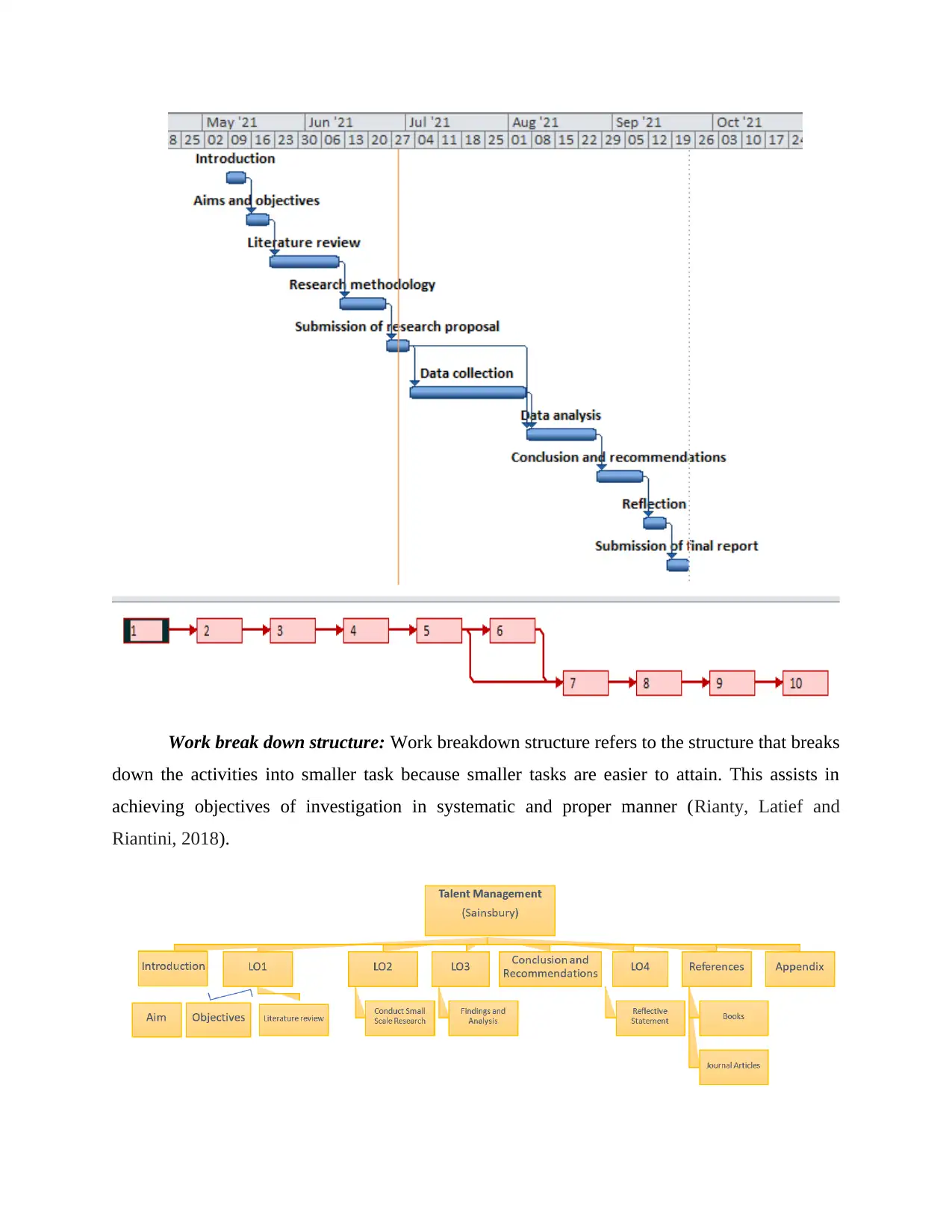
Work break down structure: Work breakdown structure refers to the structure that breaks
down the activities into smaller task because smaller tasks are easier to attain. This assists in
achieving objectives of investigation in systematic and proper manner (Rianty, Latief and
Riantini, 2018).
down the activities into smaller task because smaller tasks are easier to attain. This assists in
achieving objectives of investigation in systematic and proper manner (Rianty, Latief and
Riantini, 2018).
Paraphrase This Document
Need a fresh take? Get an instant paraphrase of this document with our AI Paraphraser
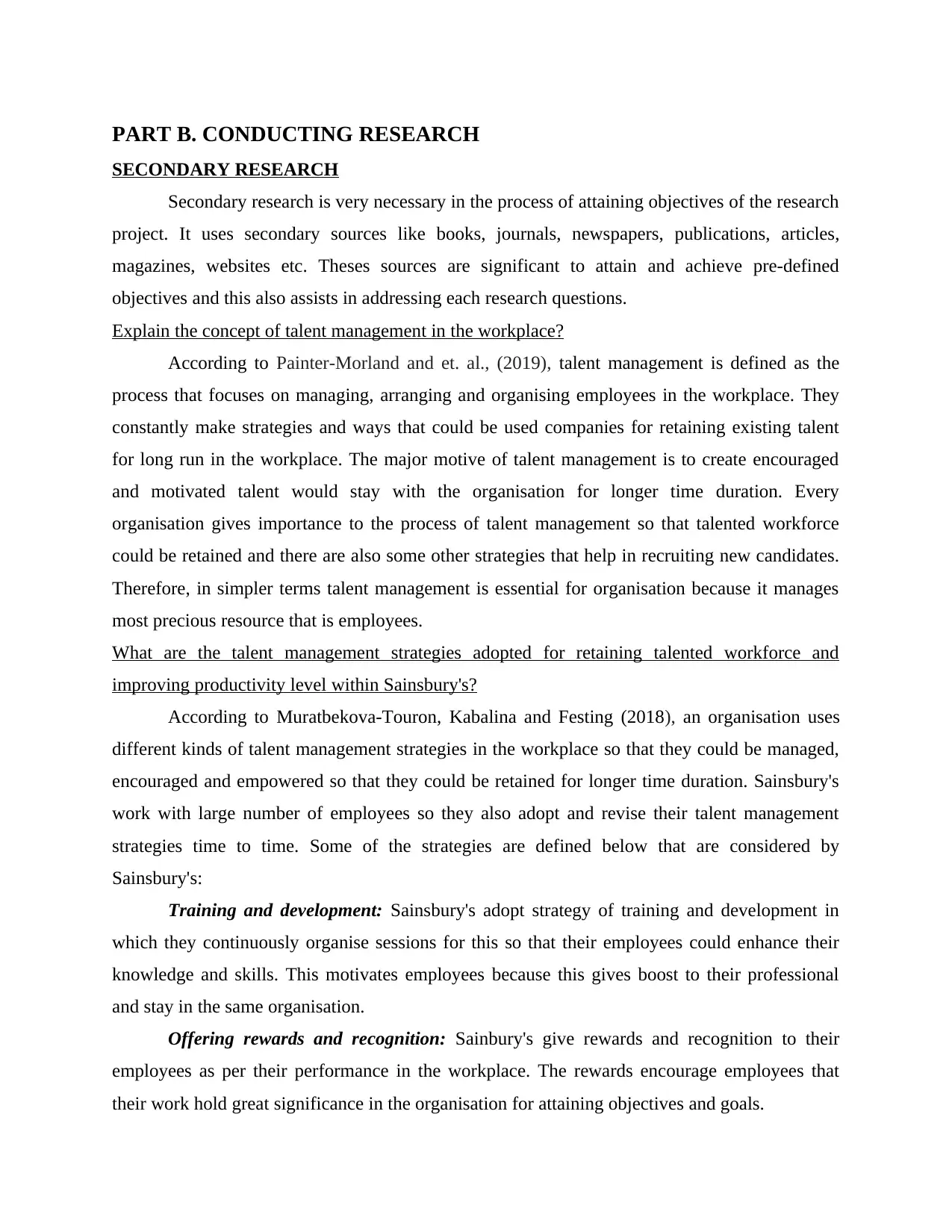
PART B. CONDUCTING RESEARCH
SECONDARY RESEARCH
Secondary research is very necessary in the process of attaining objectives of the research
project. It uses secondary sources like books, journals, newspapers, publications, articles,
magazines, websites etc. Theses sources are significant to attain and achieve pre-defined
objectives and this also assists in addressing each research questions.
Explain the concept of talent management in the workplace?
According to Painter‐Morland and et. al., (2019), talent management is defined as the
process that focuses on managing, arranging and organising employees in the workplace. They
constantly make strategies and ways that could be used companies for retaining existing talent
for long run in the workplace. The major motive of talent management is to create encouraged
and motivated talent would stay with the organisation for longer time duration. Every
organisation gives importance to the process of talent management so that talented workforce
could be retained and there are also some other strategies that help in recruiting new candidates.
Therefore, in simpler terms talent management is essential for organisation because it manages
most precious resource that is employees.
What are the talent management strategies adopted for retaining talented workforce and
improving productivity level within Sainsbury's?
According to Muratbekova‐Touron, Kabalina and Festing (2018), an organisation uses
different kinds of talent management strategies in the workplace so that they could be managed,
encouraged and empowered so that they could be retained for longer time duration. Sainsbury's
work with large number of employees so they also adopt and revise their talent management
strategies time to time. Some of the strategies are defined below that are considered by
Sainsbury's:
Training and development: Sainsbury's adopt strategy of training and development in
which they continuously organise sessions for this so that their employees could enhance their
knowledge and skills. This motivates employees because this gives boost to their professional
and stay in the same organisation.
Offering rewards and recognition: Sainbury's give rewards and recognition to their
employees as per their performance in the workplace. The rewards encourage employees that
their work hold great significance in the organisation for attaining objectives and goals.
SECONDARY RESEARCH
Secondary research is very necessary in the process of attaining objectives of the research
project. It uses secondary sources like books, journals, newspapers, publications, articles,
magazines, websites etc. Theses sources are significant to attain and achieve pre-defined
objectives and this also assists in addressing each research questions.
Explain the concept of talent management in the workplace?
According to Painter‐Morland and et. al., (2019), talent management is defined as the
process that focuses on managing, arranging and organising employees in the workplace. They
constantly make strategies and ways that could be used companies for retaining existing talent
for long run in the workplace. The major motive of talent management is to create encouraged
and motivated talent would stay with the organisation for longer time duration. Every
organisation gives importance to the process of talent management so that talented workforce
could be retained and there are also some other strategies that help in recruiting new candidates.
Therefore, in simpler terms talent management is essential for organisation because it manages
most precious resource that is employees.
What are the talent management strategies adopted for retaining talented workforce and
improving productivity level within Sainsbury's?
According to Muratbekova‐Touron, Kabalina and Festing (2018), an organisation uses
different kinds of talent management strategies in the workplace so that they could be managed,
encouraged and empowered so that they could be retained for longer time duration. Sainsbury's
work with large number of employees so they also adopt and revise their talent management
strategies time to time. Some of the strategies are defined below that are considered by
Sainsbury's:
Training and development: Sainsbury's adopt strategy of training and development in
which they continuously organise sessions for this so that their employees could enhance their
knowledge and skills. This motivates employees because this gives boost to their professional
and stay in the same organisation.
Offering rewards and recognition: Sainbury's give rewards and recognition to their
employees as per their performance in the workplace. The rewards encourage employees that
their work hold great significance in the organisation for attaining objectives and goals.
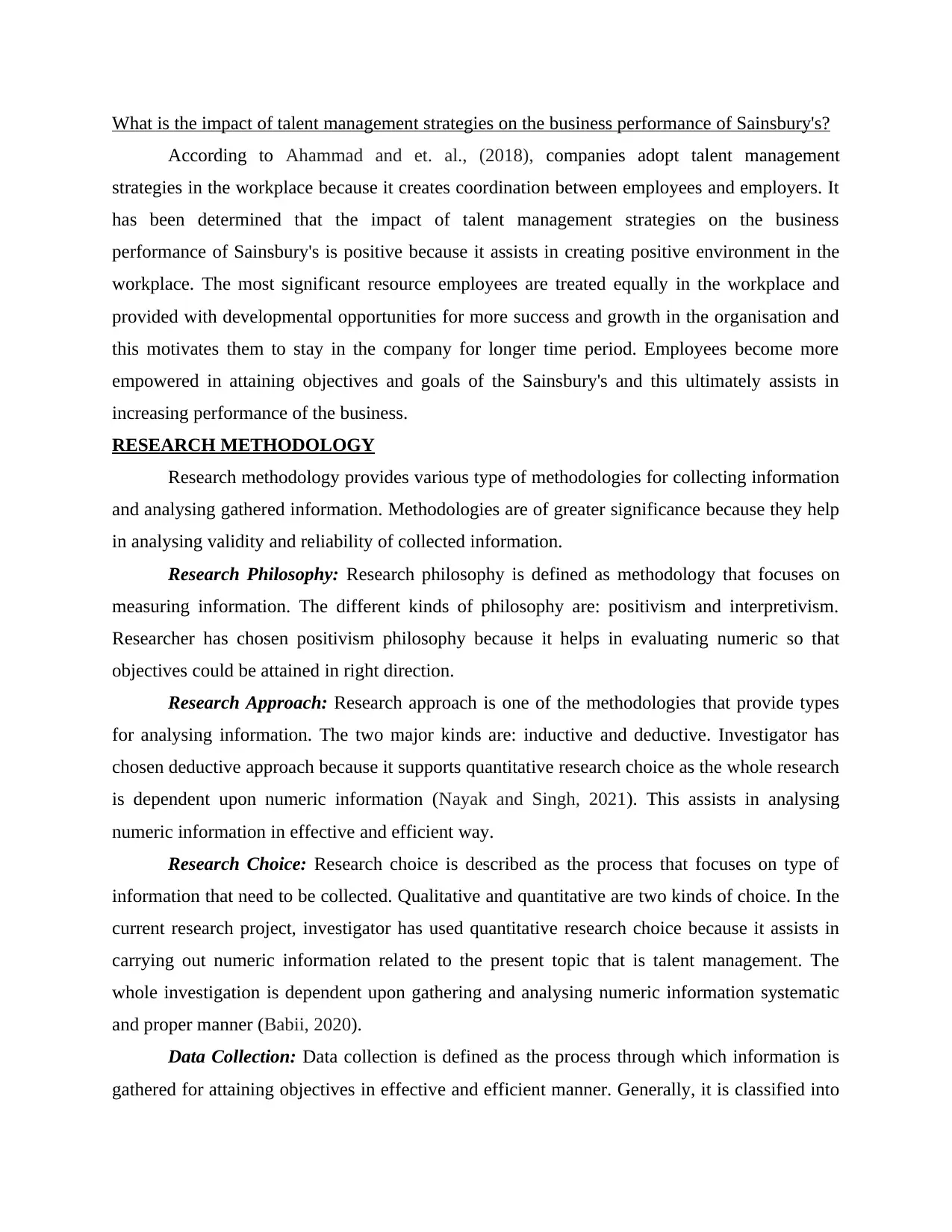
What is the impact of talent management strategies on the business performance of Sainsbury's?
According to Ahammad and et. al., (2018), companies adopt talent management
strategies in the workplace because it creates coordination between employees and employers. It
has been determined that the impact of talent management strategies on the business
performance of Sainsbury's is positive because it assists in creating positive environment in the
workplace. The most significant resource employees are treated equally in the workplace and
provided with developmental opportunities for more success and growth in the organisation and
this motivates them to stay in the company for longer time period. Employees become more
empowered in attaining objectives and goals of the Sainsbury's and this ultimately assists in
increasing performance of the business.
RESEARCH METHODOLOGY
Research methodology provides various type of methodologies for collecting information
and analysing gathered information. Methodologies are of greater significance because they help
in analysing validity and reliability of collected information.
Research Philosophy: Research philosophy is defined as methodology that focuses on
measuring information. The different kinds of philosophy are: positivism and interpretivism.
Researcher has chosen positivism philosophy because it helps in evaluating numeric so that
objectives could be attained in right direction.
Research Approach: Research approach is one of the methodologies that provide types
for analysing information. The two major kinds are: inductive and deductive. Investigator has
chosen deductive approach because it supports quantitative research choice as the whole research
is dependent upon numeric information (Nayak and Singh, 2021). This assists in analysing
numeric information in effective and efficient way.
Research Choice: Research choice is described as the process that focuses on type of
information that need to be collected. Qualitative and quantitative are two kinds of choice. In the
current research project, investigator has used quantitative research choice because it assists in
carrying out numeric information related to the present topic that is talent management. The
whole investigation is dependent upon gathering and analysing numeric information systematic
and proper manner (Babii, 2020).
Data Collection: Data collection is defined as the process through which information is
gathered for attaining objectives in effective and efficient manner. Generally, it is classified into
According to Ahammad and et. al., (2018), companies adopt talent management
strategies in the workplace because it creates coordination between employees and employers. It
has been determined that the impact of talent management strategies on the business
performance of Sainsbury's is positive because it assists in creating positive environment in the
workplace. The most significant resource employees are treated equally in the workplace and
provided with developmental opportunities for more success and growth in the organisation and
this motivates them to stay in the company for longer time period. Employees become more
empowered in attaining objectives and goals of the Sainsbury's and this ultimately assists in
increasing performance of the business.
RESEARCH METHODOLOGY
Research methodology provides various type of methodologies for collecting information
and analysing gathered information. Methodologies are of greater significance because they help
in analysing validity and reliability of collected information.
Research Philosophy: Research philosophy is defined as methodology that focuses on
measuring information. The different kinds of philosophy are: positivism and interpretivism.
Researcher has chosen positivism philosophy because it helps in evaluating numeric so that
objectives could be attained in right direction.
Research Approach: Research approach is one of the methodologies that provide types
for analysing information. The two major kinds are: inductive and deductive. Investigator has
chosen deductive approach because it supports quantitative research choice as the whole research
is dependent upon numeric information (Nayak and Singh, 2021). This assists in analysing
numeric information in effective and efficient way.
Research Choice: Research choice is described as the process that focuses on type of
information that need to be collected. Qualitative and quantitative are two kinds of choice. In the
current research project, investigator has used quantitative research choice because it assists in
carrying out numeric information related to the present topic that is talent management. The
whole investigation is dependent upon gathering and analysing numeric information systematic
and proper manner (Babii, 2020).
Data Collection: Data collection is defined as the process through which information is
gathered for attaining objectives in effective and efficient manner. Generally, it is classified into
⊘ This is a preview!⊘
Do you want full access?
Subscribe today to unlock all pages.

Trusted by 1+ million students worldwide
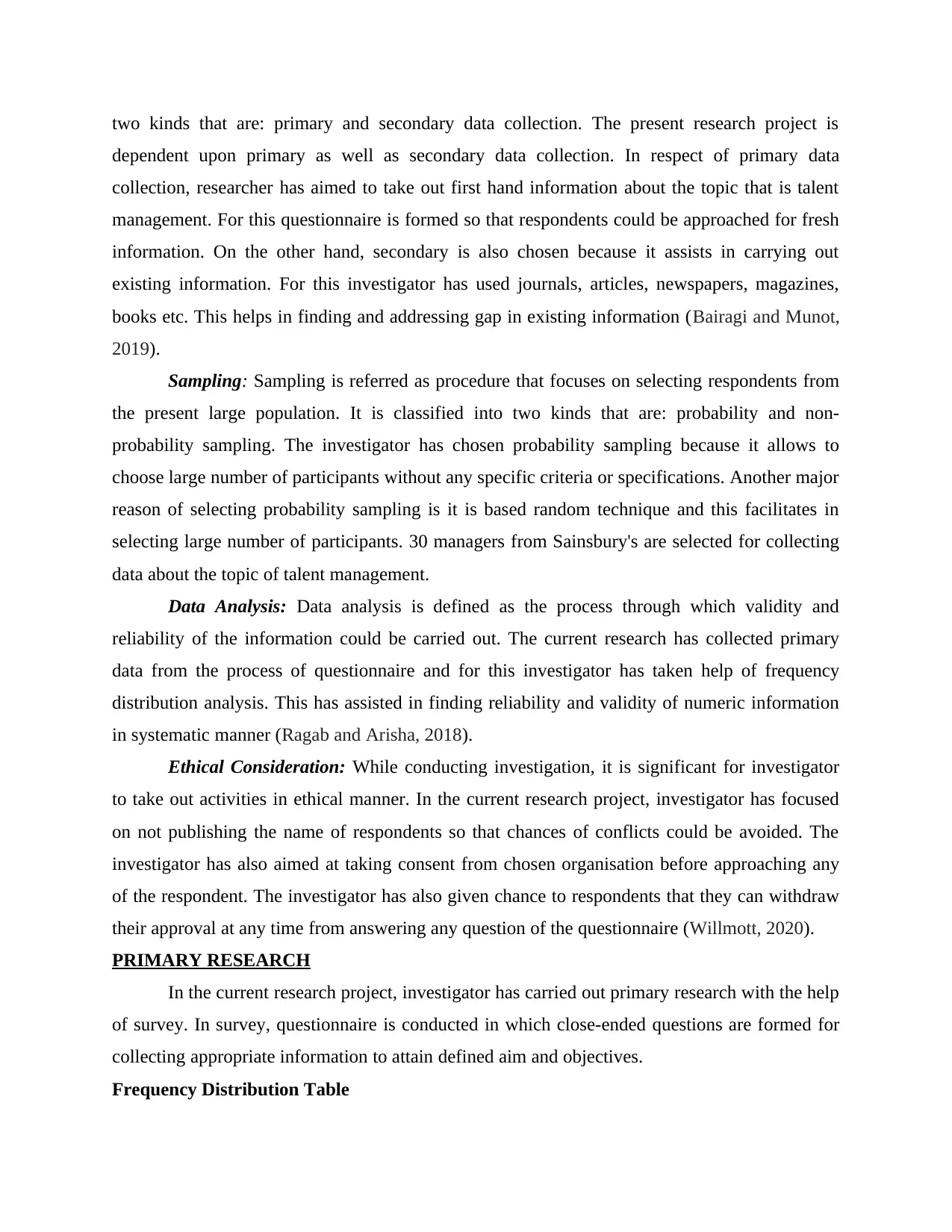
two kinds that are: primary and secondary data collection. The present research project is
dependent upon primary as well as secondary data collection. In respect of primary data
collection, researcher has aimed to take out first hand information about the topic that is talent
management. For this questionnaire is formed so that respondents could be approached for fresh
information. On the other hand, secondary is also chosen because it assists in carrying out
existing information. For this investigator has used journals, articles, newspapers, magazines,
books etc. This helps in finding and addressing gap in existing information (Bairagi and Munot,
2019).
Sampling: Sampling is referred as procedure that focuses on selecting respondents from
the present large population. It is classified into two kinds that are: probability and non-
probability sampling. The investigator has chosen probability sampling because it allows to
choose large number of participants without any specific criteria or specifications. Another major
reason of selecting probability sampling is it is based random technique and this facilitates in
selecting large number of participants. 30 managers from Sainsbury's are selected for collecting
data about the topic of talent management.
Data Analysis: Data analysis is defined as the process through which validity and
reliability of the information could be carried out. The current research has collected primary
data from the process of questionnaire and for this investigator has taken help of frequency
distribution analysis. This has assisted in finding reliability and validity of numeric information
in systematic manner (Ragab and Arisha, 2018).
Ethical Consideration: While conducting investigation, it is significant for investigator
to take out activities in ethical manner. In the current research project, investigator has focused
on not publishing the name of respondents so that chances of conflicts could be avoided. The
investigator has also aimed at taking consent from chosen organisation before approaching any
of the respondent. The investigator has also given chance to respondents that they can withdraw
their approval at any time from answering any question of the questionnaire (Willmott, 2020).
PRIMARY RESEARCH
In the current research project, investigator has carried out primary research with the help
of survey. In survey, questionnaire is conducted in which close-ended questions are formed for
collecting appropriate information to attain defined aim and objectives.
Frequency Distribution Table
dependent upon primary as well as secondary data collection. In respect of primary data
collection, researcher has aimed to take out first hand information about the topic that is talent
management. For this questionnaire is formed so that respondents could be approached for fresh
information. On the other hand, secondary is also chosen because it assists in carrying out
existing information. For this investigator has used journals, articles, newspapers, magazines,
books etc. This helps in finding and addressing gap in existing information (Bairagi and Munot,
2019).
Sampling: Sampling is referred as procedure that focuses on selecting respondents from
the present large population. It is classified into two kinds that are: probability and non-
probability sampling. The investigator has chosen probability sampling because it allows to
choose large number of participants without any specific criteria or specifications. Another major
reason of selecting probability sampling is it is based random technique and this facilitates in
selecting large number of participants. 30 managers from Sainsbury's are selected for collecting
data about the topic of talent management.
Data Analysis: Data analysis is defined as the process through which validity and
reliability of the information could be carried out. The current research has collected primary
data from the process of questionnaire and for this investigator has taken help of frequency
distribution analysis. This has assisted in finding reliability and validity of numeric information
in systematic manner (Ragab and Arisha, 2018).
Ethical Consideration: While conducting investigation, it is significant for investigator
to take out activities in ethical manner. In the current research project, investigator has focused
on not publishing the name of respondents so that chances of conflicts could be avoided. The
investigator has also aimed at taking consent from chosen organisation before approaching any
of the respondent. The investigator has also given chance to respondents that they can withdraw
their approval at any time from answering any question of the questionnaire (Willmott, 2020).
PRIMARY RESEARCH
In the current research project, investigator has carried out primary research with the help
of survey. In survey, questionnaire is conducted in which close-ended questions are formed for
collecting appropriate information to attain defined aim and objectives.
Frequency Distribution Table
Paraphrase This Document
Need a fresh take? Get an instant paraphrase of this document with our AI Paraphraser
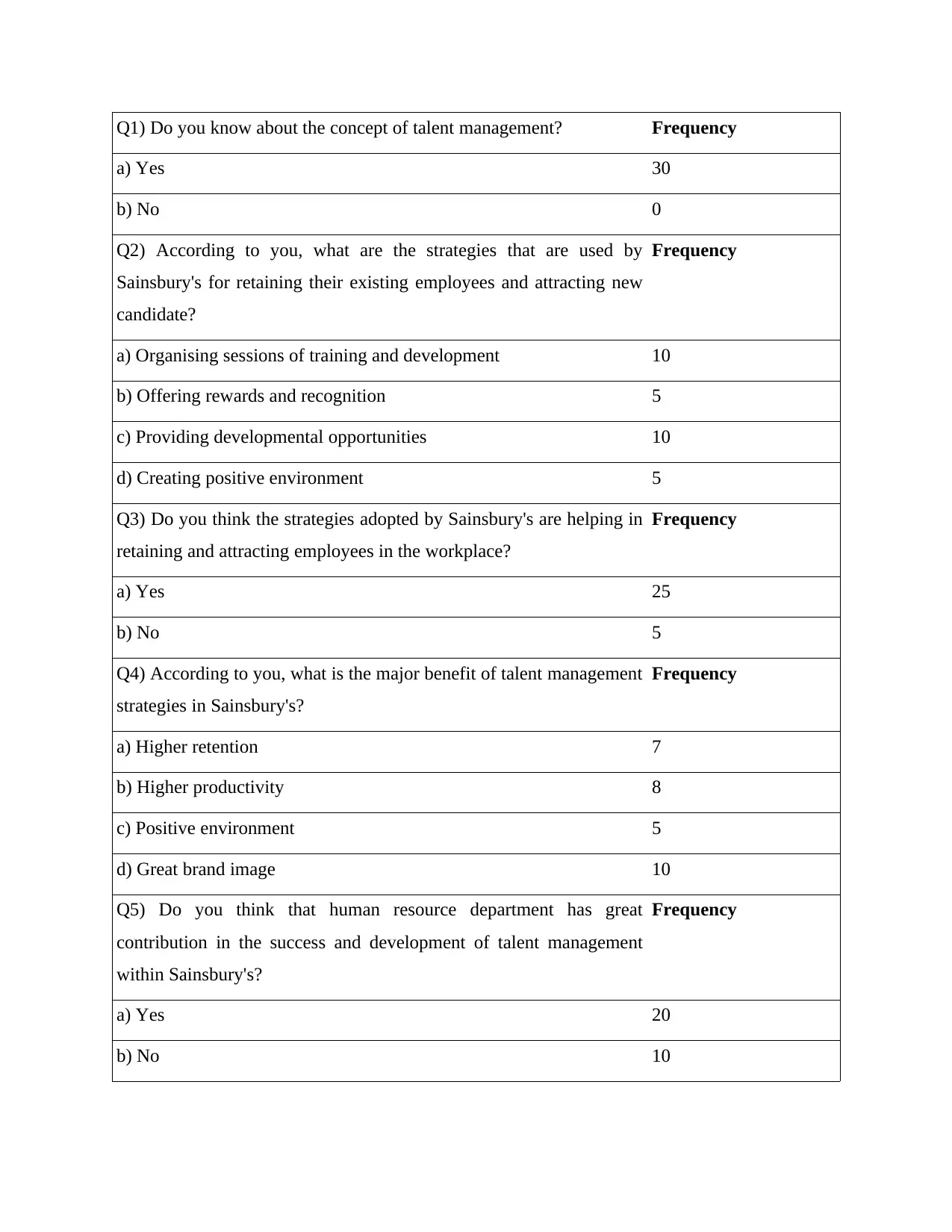
Q1) Do you know about the concept of talent management? Frequency
a) Yes 30
b) No 0
Q2) According to you, what are the strategies that are used by
Sainsbury's for retaining their existing employees and attracting new
candidate?
Frequency
a) Organising sessions of training and development 10
b) Offering rewards and recognition 5
c) Providing developmental opportunities 10
d) Creating positive environment 5
Q3) Do you think the strategies adopted by Sainsbury's are helping in
retaining and attracting employees in the workplace?
Frequency
a) Yes 25
b) No 5
Q4) According to you, what is the major benefit of talent management
strategies in Sainsbury's?
Frequency
a) Higher retention 7
b) Higher productivity 8
c) Positive environment 5
d) Great brand image 10
Q5) Do you think that human resource department has great
contribution in the success and development of talent management
within Sainsbury's?
Frequency
a) Yes 20
b) No 10
a) Yes 30
b) No 0
Q2) According to you, what are the strategies that are used by
Sainsbury's for retaining their existing employees and attracting new
candidate?
Frequency
a) Organising sessions of training and development 10
b) Offering rewards and recognition 5
c) Providing developmental opportunities 10
d) Creating positive environment 5
Q3) Do you think the strategies adopted by Sainsbury's are helping in
retaining and attracting employees in the workplace?
Frequency
a) Yes 25
b) No 5
Q4) According to you, what is the major benefit of talent management
strategies in Sainsbury's?
Frequency
a) Higher retention 7
b) Higher productivity 8
c) Positive environment 5
d) Great brand image 10
Q5) Do you think that human resource department has great
contribution in the success and development of talent management
within Sainsbury's?
Frequency
a) Yes 20
b) No 10

⊘ This is a preview!⊘
Do you want full access?
Subscribe today to unlock all pages.

Trusted by 1+ million students worldwide
1 out of 24
Related Documents
Your All-in-One AI-Powered Toolkit for Academic Success.
+13062052269
info@desklib.com
Available 24*7 on WhatsApp / Email
![[object Object]](/_next/static/media/star-bottom.7253800d.svg)
Unlock your academic potential
Copyright © 2020–2025 A2Z Services. All Rights Reserved. Developed and managed by ZUCOL.




